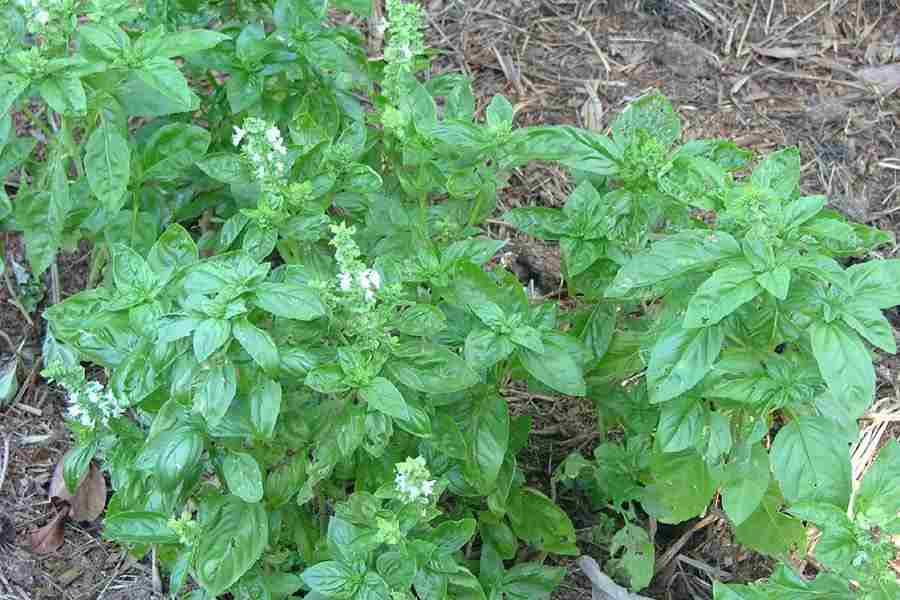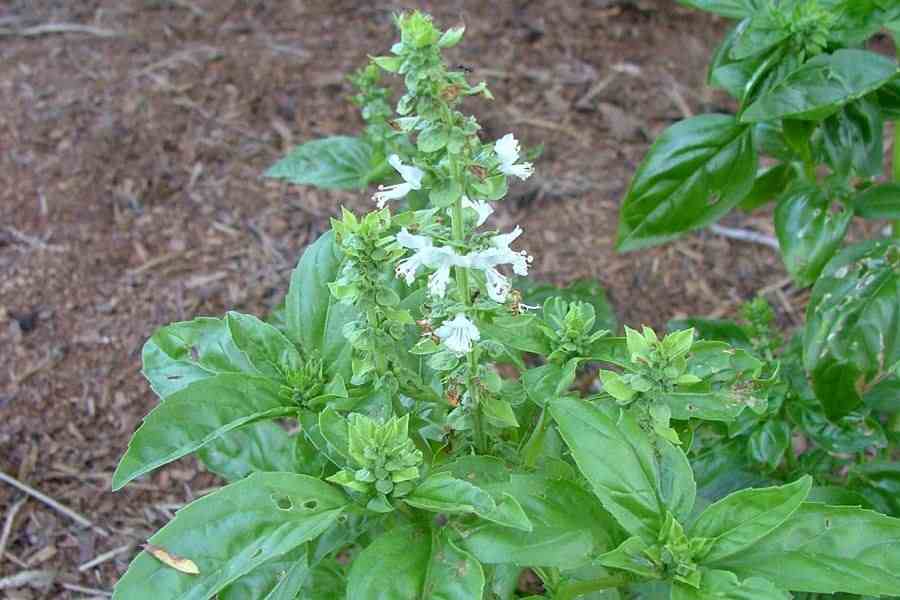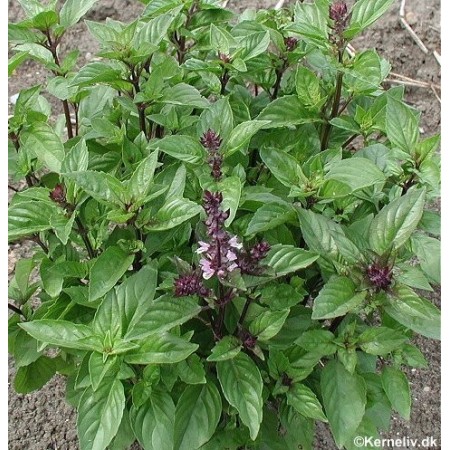Ocimum basilicum L.
| Botanical Name | Ocimum basilicum L. |
| Order: | Lamiales |
| Family: | Lamiaceae |
| Genus: | Ocimum |
| Species: | O. basilicum |
| Common Names: | English: Sweet Basil French: Basilic, Basilic aux sauces, Basilic commun, Basilic romain, Framboisin (Antilles), Herbe Royale, Oranger Savetiers, Des Pistou. |
Plant Synonyms
Ocimum lanceolatum Schum & Tonn,
Ocimum dicotomum Hochst ex Benth.,
Ocimum americanum L.,
Ocimum. menthaefolium A. Chev.,
Ocimum album,
Ocimum anisatum,
Ocimum barrelieri,
Ocimum medium,
Plectranthus barrelieri
Plant Local Names
Burkina Faso: Moore - Yulin-gnuuga, Diouia - chou kolan, Fulfulde- Ngungune;guguma
Cote d'lvoire: Baule - Emia
Ghana: Akan - Nunum, Ga - Sulu, Ewe - Dzevetu
Mali: Bambara- Chou kolan
Nigeria: Yoruba - efinrin wewe
Sierra Leone: Kono - Peinga
Togo: Akasalem - Kunyonyo
Plant Habitat
The plant thrives well in light (sandy) and medium (loamy) well-drained soils; prefers acidic, neutral and basic (alkaline) soils. It cannot grow in the shade; requiring moist soil, preferably on cultivated beds.
Plant Material of Interest
Leaf, Flower
Plant Description
Small, annual aromatic herb, sub-shrub, or shrub; stems quadrangular, branched and forming compact balls of light green color generally; serrated leaves, clearly stalked, thin, elliptical, ovate or oblong cuneate at the base, acuminate at apex, 2 to 4 cm long; whorled inflorescence up to 20 cm, pedicels very short, curved, loose terminal racemes of white flowers, white petals measuring 4-5 mm, calyx lobes orbicular to higher than 6 mm in diameter, calyx ovoid to campanulate, limb 2-lipped; upper lip 3- toothed, middle tooth circular to obovate, margin winged, decurrent, lateral teeth shorter; lower lip 2 toothed , teeth narrower, apex acuminate to spinescent, sometimes approximate, corolla tube slightly shorter than calyx or rarely exserted, dilated, obliquely campanulate at throat; limb 2- lipped, upper lip subequally (3- or 4 -lobed); lower lip somewhat elongated or not, declined, margin entire, flat or slightly concave, stamens 4, exserted, declined on lower corolla lip, anterior 2 longer; filaments free or anterior 2 connate at base; anthers ovoid-reniform, 1-locellate, style longer than stamens, 2-cleft at apex; lobes sub - equal, subulate or flat; nutlets ovoid.
Plant Used Parts
Plant Uses
Sweet basil has been used for thousands of years as a culinary and medicinal herb. It acts principally on the digestive and nervous systems, easing flatulence, stomach cramps, colic and indigestion. The leaves and flowering tops are antispasmodic, aromatic, carminative, digestive, galactogogue, stomachic and tonic (Singh et al,, 2011). It is taken internally in the treatment of feverish illnesses (especially colds and influenza), poor digestion, nausea, and abdominal cramps, gastro-enteritis, migraine, insomnia, depression and exhaustion. It is externally used to treat acne, loss of smell, insect stings, snake bites and skin infections. The leaves can be harvested throughout the growing season and are used fresh or dried (Njorege, 2006). The mucilaginous seed is taken as an infusion in the treatment of gonorrhoea, dysentery and chronic diarrhoea, and it is claimed to remove film and opacity from the eyes. The root is used in the treatment of bowel complaints in children. Extracts from the plant are bactericidal and anti-parasitic. in India, sweet basil is used for dental ailments due to its proposed antimicrobial effects (Patel and venkatakrishna, 1988). The essential oil is used in aromatherapy.
Plant Therapeutic Action
Antiasthmatic, anticonvulsant/ insect repellant, antiflatulence
Plant Precaution for Use
Caution should be taken in patients with hypoglycaemia and liver disease. Basil oil contains estragole a potentially carcinogenic and mutagenic agent. It should not be taken during pregnancy or given to small infants/children
Plant Adverse Effect
Possible hypoglycaemia and hepatic dysfunction.
Plant Contraindication
Pregnancy and liver disease
Plant Dosage Forms
Decoction, instillation, paste.
Plant Dosage
Decoction: 30 g plant material in 900 ml water; simmer until reduced to 600 ml; 1 tablespoonful two times daily.
Plant Storage
Store in a cool dry place
Plant Chromatographic Fingerprint
Plant Constituents
Essential oils (contains linalool, epi-a-cadinol, a- bergamotene, Y"cadinene, eugenol, chavicol, linalool, anethole, estragole, limonene, cuminaldehyde, a-terpineol and clnamic acid derivatives (Abdulah et al., 2008; Politeo, 2007).
Plant References
Balambal, R., T-hiruvengadam, K.V., Kameswarant, L., Janaki, V.R., Thambiah, A.S. (1985). Ocimum basilicum in acne vulgaris--a controlled comparison with a standard regime. Journal of Association of Physicians India 33(8):507-508.
Buch, J.G., Dikshit, R.K., Mansuri, S.M. (1988). Effect of certain volatile oils on ejaculated human spermatozoa. Indian Journal of Medical Research 87(4):361-363.
Manosroi, J., Dhumtanom, P., Manosroi, A. (2006). Anti-proliferative activity of essential oil extracted from Thai medicinal plants on KB and P388 cell lines. Cancer Letters 235(1 ):114-120.
Niture, S.K., Rao, U.S., Srivenugopal, K.S. (2006). Chemopreventative strategies targeting the MGMT repair protein: augmented expression in human lymphocytes and tumor cells by ethanolic and aqueous extracts of several Indian medicinal plants. International Journal of Oncology 29(5):1269-1278.
Njorege, G.N., Bussman, R.W. (2006). Traditional management of ear, nose and thorat (ENT) diseases in central Kenya. Journal of Ethnobotany and Ethnomedicine 2(1): 54.
Opalchenova, G., Obreshkova, D. (2003). Comparative studies on the activity of basil-an essential oil from Ocimum basilicum L.--against multidrug resistant clinical isolates of the genera Staphylococcus, Enterococcus and Pseudomonas by using different test methods. Journal of Microbiology Methods 54(1 ):105-110.
Patel, V.K., Venkatakrishna-Bhatt, H. (1988). Folklore therapeutic indigenous plants in periodontal disorders in India (review, experimental and clinical approach). Internationa Journal of Clinical Pharmacology, Therapeutics and Toxicology 26(4): 176-184.
Politeo, O., Jukic, M., Milos, M. (2007). Chemical composition and antioxidant capacity of free volatile aglycones from basil (Ocimum basilicum L.) compared with its essential oil. Food Chemistry 101(1): 379-385.


